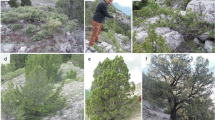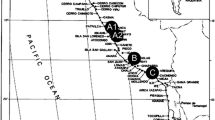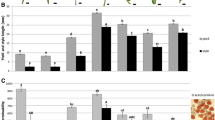Abstract
Interspecific hybridization played an important role in speciation and evolution of angiosperms. Although the widespread occurrence of natural hybrids in the genus Potamogeton has been studied intensively, few successful experimental hybridization studies have been reported in this genus. In the present study, critical experimental hybridization was conducted using Potamogeton × intortusifolius, a natural hybrid widely distributed in China, and its parents (P. perfoliatus and P. wrightii). The absence of prezygotic barriers between P. wrightii and P. perfoliatus was observed, which contributes to the frequent hybridization of these species in nature. The pollen tube growth rates of P. perfoliatus were much faster than those of P. wrightii in the style of that species. However, the conspecific pollen tubes were competitively advantageous in P. perfoliatus styles. The interspecific hybridization could be applied bidirectionally, and 28 F1 hybrid individuals were successfully obtained from P. wrightii × P. perfoliatus, despite the low germination possibility of the hybrid seeds. Both the artificial and natural hybrids exhibited intermediate morphological characters but presented much lower fertility. The sterility of P. × intortusifolius is mainly due to its low female fitness. However, the offspring from P. wrightii × P. × intortusifolius indicated the potential for backcrossing in nature. This is the most successful attempt at artificial hybridization in this genus so far. The possible route for restoration of fertility and the fitness of the hybrids are also discussed in this paper.


Similar content being viewed by others
References
Alix MS, Scribailo RW (2006) First report of Potamogeton × undulates (P. crispus × P. praelongus, Potamogetonaceae) in North America, with notes on morphology and stem anatomy. Rhodora 108(936):329–346
Arnold ML (1992) Natural hybridization as an evolutionary process. Annu Rev Ecol Syst 23:237–261
Arnold ML (1997) Natural hybridization and evolution. Oxford University Press, New York
Arnold ML, Hodges SA (1995) Are natural hybrids fit or unfit relative to their parents? Trends Ecol Evol 10(2):67–71
Charlesworth B, Charlesworth D (2000) Reproductive isolation: natural selection at work. Curr Biol 10:68–70
Cook CDK (1988) Wind pollination in aquatic angiosperms. Ann Mo Bot Gard 75:768–777
Diaz A, Macnair MR (1999) Pollen tube competition as a mechanism of prezygotic reproductive isolation between Mimulus nasutus and its presumed progenitor M. guttatus. New Phytol 144:471–478
Du ZY, Yang CF, Chen JM, Guo YH (2009) Nuclear and chloroplast DNA sequences data support the origin of Potamogeton intortusifolius J. B. He in China as a hybrid between P. perfoliatus Linn. and P. wrightii Morong. Aquat Bot 91:47–50
Fant JB, Preston CD (2004) Genetic structure and morphological variation of the British populations of the hybrid Potamogeton × salicifolius. Bot J Linn Soc 144:99–111
Fant JB, Preston CD, Barrett JA (2001a) Isozyme evidence for the origin of Potamogeton × sudermanicus as a hybrid between P. acutifolius and P. berchtoldii. Aquat Bot 71:199–208
Fant JB, Preston CD, Barrett JA (2001b) Isozyme evidence of the parental origin and possible fertility of the hybrid Potamogeton × fluitans Roth. Plant Syst Evol 229:45–57
Fant JB, Kamau E, Preston CD (2003) Chloroplast evidence for the multiple origins of the hybrid Potamogeton × sudermanicus Hagstr. Aquat Bot 75:351–356
Fant JB, Kamau E, Preston CD (2005) Chloroplast evidence for the multiple origins of the hybrid Potamogeton × fluitans. Aquat Bot 83:154–160
Guo YH, Cook CDK (1990) The floral biology of Groenlandia densa (L.) Fourreau (Potamogetonaceae). Aquat Bot 38:283–288
Hagström JO (1916) Critical researches on the Potamogetons. Kongl Svensk Vetensk Akad Handl 55:1–281
Hay F, Probert R, Dawson M (2008) Laboratory germination of seeds from 10 British species of Potamogeton. Aquat Bot 88:353–357
He JB, Zhou LY, Wang HQ (1988) New plants in Hubei China. Bull Bot Res Sin 8:125–127
Hellquist CB, Crow GE (1986) Potamogeton × haynesii (Potamogetonaceae), a new species from northeastern North America. Brittonia 38(4):415–419
Hollingsworth PM, Preston CD, Gornall RJ (1995) Isozyme evidence for hybridization between Potamogeton natans and P. nodosus (Potamogetonaceae) in Britain. Bot J Linn Soc 117:59–69
Iida S, Kadono Y (2002) Genetic diversity and origin of Potamogeton anguillanus (Potamogetonaceae) in Lake Biwa, Japan. J Plant Res 115:11–16
Kaplan Z (2001) Potamogeton × fluitans (P. natans × P. lucens) in the Czech Republic I. Morphology and anatomy. Preslia 73:333–340
Kaplan Z (2007) First record of Potamogeton × salicifolius for Italy, with isozyme evidence for plants collected in Italy and Sweden. Plant Biosyst 141(3):344–351
Kaplan Z, Fehrer J (2004) Evidence for the hybrid origin of Potamogeton × cooperi (Potamogetonaceae): traditional morphology-based taxonomy and molecular techniques in concert. Folia Geobot 39:431–453
Kaplan Z, Fehrer J (2006) Comparison of natural and artificial hybridization in Potamogeton. Preslia 78:303–316
Kaplan Z, Štěpánek J (2003) Genetic variation within and between populations of Potamogeton pusillus agg. Plant Syst Evol 239:95–112
Kaplan Z, Wolff P (2004) A morphological, anatomical and isozyme study of Potamogeton × schreberi: confirmation of its recent occurrence in Germany and first documented record in France. Preslia 76:141–161
Kearns CA, Inouye DW (1993) Techniques for pollination biologists. University Press of Colorado, Niwot
Khatun S, Flowers TJ (1995) The estimation of pollen viability in rice. J Exp Bot 46(282):51–154
Lee CB, Page LE, McClure BA, Holtsford TP (2008) Post-pollination hybridization barriers in Nicotiana section Alatae. Sex Plant Reprod 21:183–195
Mayr E (1992) A local flora and the biological species concept. Am J Bot 79(2):222–238
Plitmann U, Levin DA (1983) Pollen–pistil relationships in the Polemoniaceae. Evolution 37:957–967
Preston CD (1995a) Pondweeds of Great Britain and Ireland. Botanical Society of the British Isles, London
Preston CD (1995b) Potamogeton × schreberi G. Fisch. (P. natans L. × P. nodosus Poir) in Dorset, new to the British Isles. Watsonia 20:255–262
Preston CD, Hollingsworth PM, Gornall RJ (1998) Potamogeton pectinatus L. × P. vaginatus Turcz. (P. × bottnicus Hagstr.), a newly identified hybrid in the British Isles. Watsonia 22:69–82
Rieseberg LH (1995) The role of hybridization in evolution: old wine in new skins. Am J Bot 82(7):944–953
Rieseberg LH (1997) Hybrid origins of plant species. Annu Rev Ecol Syst 28:359–389
Rieseberg LH, Ellstrand NC (1993) What can molecular and morphological markers tell us about plant hybridization? Crit Rev Plant Sci 12(3):213–241
Rieseberg LH, Willis JH (2007) Plant speciation. Science 317:910–914
Rodriguez-Riano T, Dafni A (2000) A new procedure to assess pollen viability. Sex Plant Reprod 12:241–244
Sculthorpe CD (1967) The biology of aquatic vascular plants. St. Martin’s Press, New York
Stace CA (1975) Hybridization: and the flora of the British Isles. Academic Press, London
Stebbins GL (1950) Variation and evolution in plants. Columbia University Press, New York
Stebbins GL (1971) Chromosomal evolution in higher plants. Edward Arnold, London
Stone JL, Thomson JD, Dent-Acosta SJ (1995) Assessment of pollen viability in hand-pollination experiments: a review. Am J Bot 82(9):1186–1197
Wagner WH Jr (1969) The role of taxonomic treatment of hybrids. Bioscience 19(9):785–795
Wagner WH Jr (1970) Biosystematics and evolutionary noise. Taxon 19(2):146–151
Whittall JB, Hellquist CB, Schneider EL, Hodges SA (2004) Cryptic species in an endangered pondweed community (Potamogeton, Potamogetonaceae) revealed by AFLP markers. Am J Bot 91:2022–2029
Wiegleb G, Kaplan Z (1998) An account of the species of Potamogeton L. (Potamogetonaceae). Folia Geobot 33:241–316
Zhang XL, Gituru RW, Yang CF, Guo YH (2009) Variations of floral traits among different life forms illustrate the evolution of pollination systems in Potamogeton species from China. Aquat Bot 90(2):124–128
Zhang XL, Gituru RW, Yang CF, Guo YH (2010) Exposure to water increased pollen longevity of pondweed (Potamogeton spp.) indicates different mechanisms ensuring pollination success of angiosperms in aquatic habitat. Evol Ecol 24:939–953
Acknowledgments
The authors would like to thank Dr. Chun-feng Yang for his helpful suggestions and comments on the manuscript. Special thanks go to Zhi-Yuan Du, Tao Wan, and Ying Zhang for their assistance in the fieldwork. We are grateful to Xu Yang for his help in the laboratory. We would also like to thank the editor and the two anonymous reviewers for their helpful suggestions. This study was supported by a grant from the National Natural Science Foundation of China (No. 30430050) and a China Postdoctoral Science Foundation (20100471210).
Author information
Authors and Affiliations
Corresponding author
Rights and permissions
About this article
Cite this article
Zhang, XL., Li, XX., Ni, LY. et al. When interspecific prezygotic barriers break down: hybridization between two Potamogeton species (P. wrightii and P. perfoliatus) and comparison of the artificial and natural hybrids. Plant Syst Evol 295, 119–128 (2011). https://doi.org/10.1007/s00606-011-0470-y
Received:
Accepted:
Published:
Issue Date:
DOI: https://doi.org/10.1007/s00606-011-0470-y






